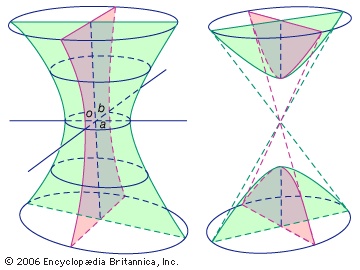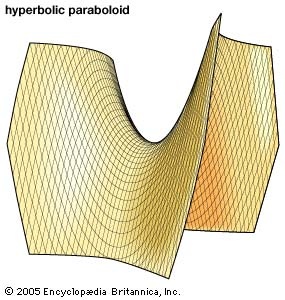algebraic surface
in three-dimensional space, a surface the equation of which is f(x,y,z)=0, with f(x,y,z) a polynomial in x, y, z. The order of the surface is the degree of the polynomial equation. If the surface is of the first order, it is a plane. If the surface is of order two, it is called a quadric surface. By rotating the surface, its equation can be put in the form
Ax2 + By2 + Cz2 + Dx+ Ey + Fz= G.
 If A, B, C are all not zero, the equation can generally be simplified to the form
If A, B, C are all not zero, the equation can generally be simplified to the form ax2+by2+cz2=1.
This surface is called an ellipsoid if a, b, and c are positive. If one of the coefficients is negative, the surface is a hyperboloid of one sheet; if two of the coefficients are negative, the surface is a hyperboloid of two sheets. A hyperboloid of one sheet has a saddle point (a point on a curved surface shaped like a saddle at which the curvatures in two mutually perpendicular planes are of opposite signs, just like a saddle is curved up in one direction and down in another).
 If A, B, C are possibly zero, then cylinders, cones, planes, and elliptic or hyperbolic paraboloids may be produced. Examples of the latter are z=x2+y2 and z=x2−y2, respectively. Through every point of a quadric pass two straight lines lying on the surface. A cubic surface is one of order three. It has the property that 27 lines lie on it, each one meeting 10 others. In general, a surface of order four or more contains no straight lines.
If A, B, C are possibly zero, then cylinders, cones, planes, and elliptic or hyperbolic paraboloids may be produced. Examples of the latter are z=x2+y2 and z=x2−y2, respectively. Through every point of a quadric pass two straight lines lying on the surface. A cubic surface is one of order three. It has the property that 27 lines lie on it, each one meeting 10 others. In general, a surface of order four or more contains no straight lines.- Allen, Sir Hugh
- Allen, Sir James
- Allen, Steve
- Allen Tate
- Allentown
- Allen, Viola
- Allen, Walter
- Allen W. Dulles
- Allen, William
- Allen, Woody
- Allerdale
- allergen
- allergy
- Alleyn, Edward
- all fours
- Allgemeine Enzyklopädie der Wissenschaften und Künste
- Allgemeine Zeitung
- Allgood, Sara
- Alliaceae
- Alliance
- alliance
- Alliance for Progress
- Alliance Israélite Universelle
- Alliance Party of Northern Ireland
- Allied air strength, September 1939